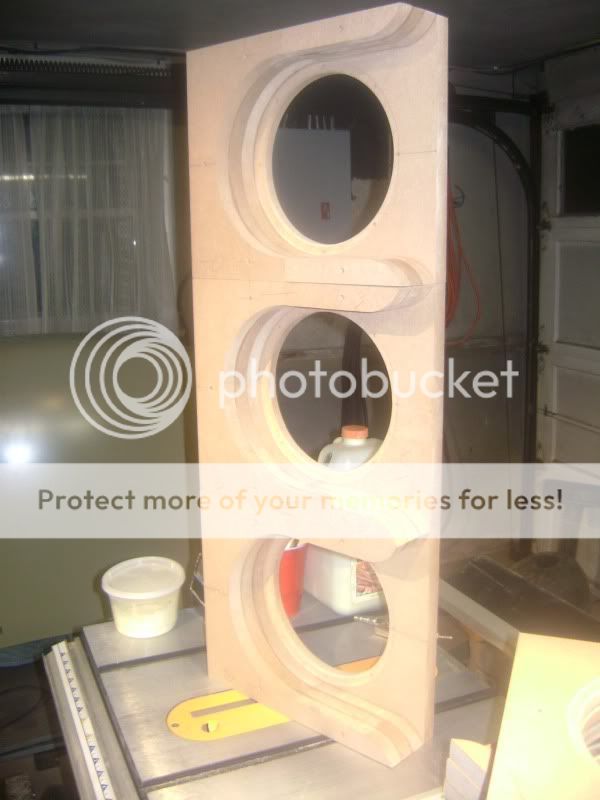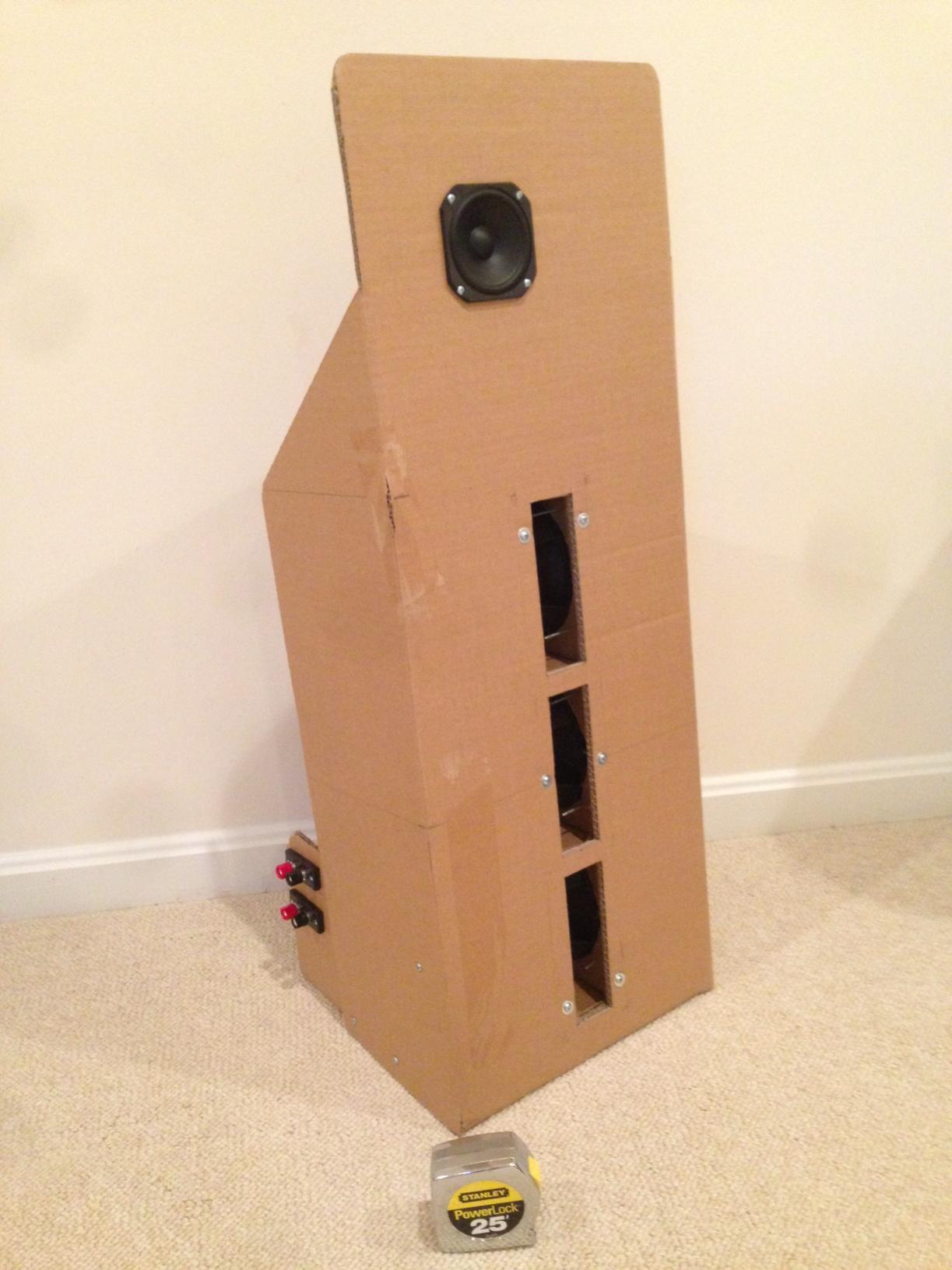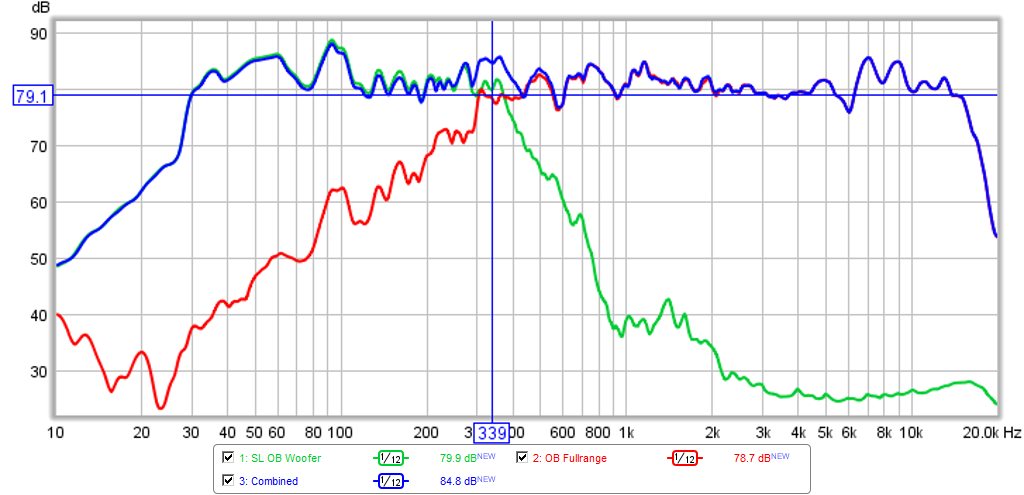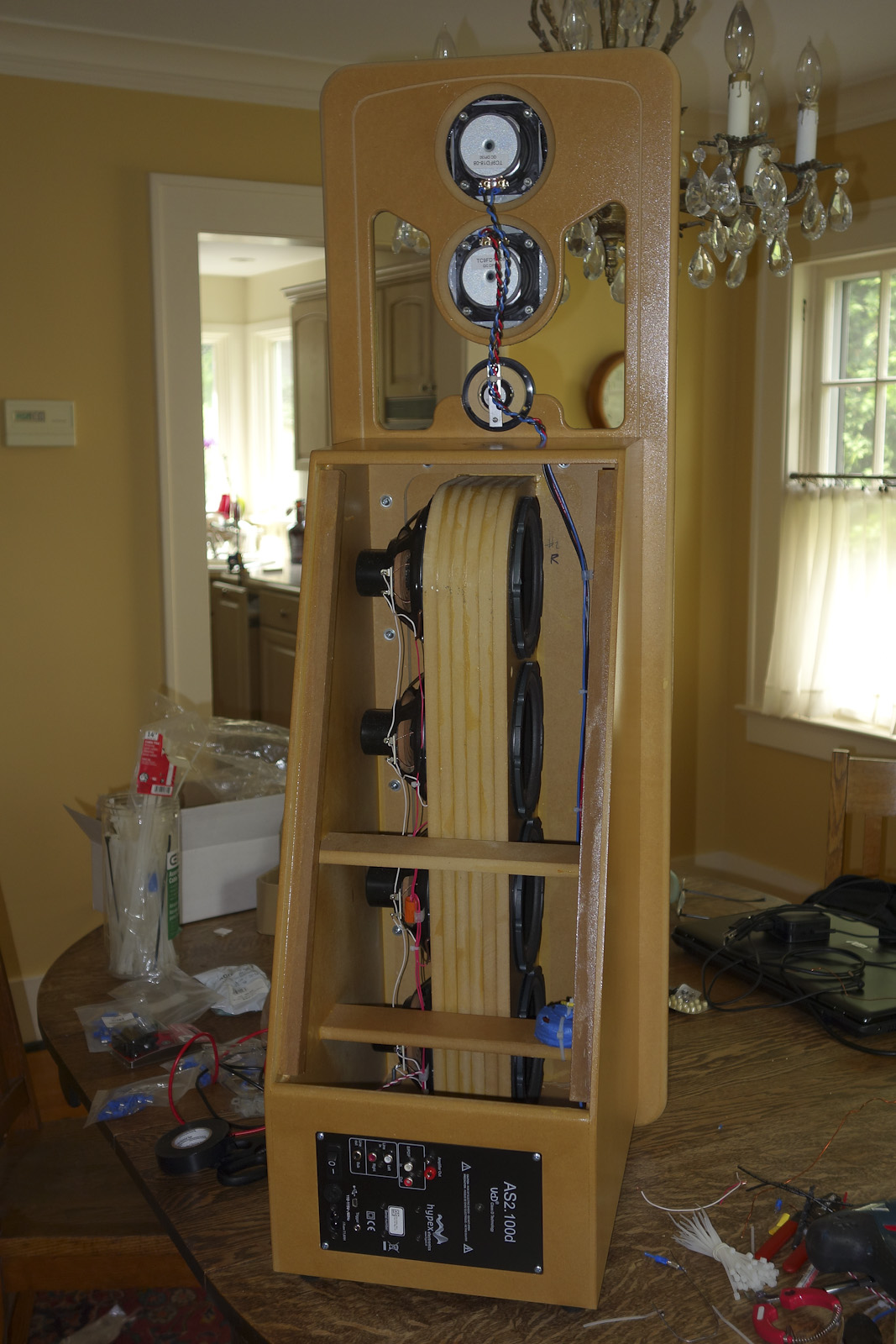No Kevin, you're not hijacking the thread at all. Actually, you gave me some really good insight on the design. The way you have the driver and the "chamber" around it is exactly what I was thinking, but just needed clarification on.
Does it matter if the driver is in that location or can it be moved even closer to the edge, closer to the mouth of the slot? That would make the chamber a little smaller.
Does it matter if the driver is in that location or can it be moved even closer to the edge, closer to the mouth of the slot? That would make the chamber a little smaller.
Does it matter if the driver is in that location or can it be moved even closer to the edge, closer to the mouth of the slot? That would make the chamber a little smaller.
I'm not sure what effect changing the overall size of the chamber will have or what changing the placement of the driver from front to rear in the chamber may result in.
I was interested in MJK's comments at the beginning of this thread:
"How much efficiency, the slot depth and cavity dimensions, baffle size around the slot, the OB size and shape, and the crossover points need to be calculated carefully to get an optimum balanced SPL response."
I wish I knew how this could be modeled, and I even played around with the Edge program a little to see what happened. I was simply guessing about whether the baffle should be modeled to have 3 arrays of two drivers stacked vertically with the dimensions of each slot defining them or if it should be an array with 6 drivers with one overall slot dimension. As far as I know there is no way to even define efficiency of the drivers in the program, let alone chamber depth or any of the other things we are talking about.
Maybe the Speaker Response Modeler could do something, but to be honest I haven't even begun to throw myself into learning it yet. I really just wanted to get down to doing what I like best which is building things. I'm hoping that with enough awareness of the issues involved with OB design and some creativity that I will be able to put together a flexible enough active crossover solution and get things right through experimentation. I will have to translate that into a passive design later if that is where I decide I want to go.
John K seemed to focus on getting the drivers as close as possible to the mouth of the slot and also overlapped the baffles that the speakers mount to with the material forming the chamber in a way that seems to try reducing the chamber volume as much as possible while maintaining the proper slot size at the mouth.
CLS's experiment with creating a slot chamber that used a single driver and actually used the floor to help form the slot allowed the driver to sit back further in a larger almost triangular chamber.
Honestly, I was taking my best guess from the pictures in the article. In my mind I had formed a mental image of the layout based on my perception of the scale of the chamber assembly in relation to the size of the speakers.
My first impression was that the speakers were mounted about 2" from the back edge of the assembly and that the overall depth from front to back looked to be about 12". I figured some of the material near the mouth was hidden by a lap joint with the front baffle. However, after re-examining the pictures I realized I didn't get the placement of the driver from front to back quite the same. I still think the overall depth is about 12", but it looks like the speaker is more likely placed closer to the mouth of the chamber. The placement is probably closer to about 1" away from the front edge and about 3" from the rear edge.
I have to make some adjustments to the depth of the boards used to form the baffles for the speakers anyway. When I cut the small pieces that are used to form the throat leading to the slot mouth I had a brain fart and made them all 1/8th of an inch short. The depth of speaker baffles themselves were cut to approximate the original depth as I purchased a couple of the 2' X 4' "easyboards" in MDF from Home Despot and although they give you some extra material on the length, there isn't enough to actually rip two boards exactly 12 inches wide from them. I ended up making them 11 3/4".
I still think the height and shape of the chamber is accurate based on the cross-sectional diagrams. Although I was going to add a taper or bevel that lead to the mouth of the slot so that I achieved the actual proper dimensions of the slot within the chamber assembly. I may reduce the distance between the drivers and the slot mouth more. As it stands I can always build it back up with spacers to play with the throat depth and overall volume of the chamber.
I guess the only thing I will have lost is some of the mass of the material used behind the driver's chamber in the original design, but that will most likely be added back on when I devise a way to mount the chambers to each other and the slot baffle.
Regards
Kevin
Kevin, you've got my head running around in circles thinking of how to go about doing the slot, and I think I might go with the drivers 2" from the edge of the slot like you did. However, instead of leaving the internal "braces" (if you will) straight that create the individual chambers, I'm going to make them more like a tear drop shape, almost creating a minor compression chamber like in a horn. This will give some "lips" to the slot, then of course the edges of the slot being rounded over as well.
With that said, this past weekend I decided to swap the Alpair 10.2's over to the Monarchy Audio Sm-70 Pro. I can honestly say that these drivers take very well to quality amplification. Right off the bat, I noticed a much fuller, smoother and 3-dimensional sound coming from the 10.2's. Using the built-in crossover in my Onkyo TX-NR809 receiver, I have them playing from 40Hz up and the Polk subs from 125Hz on down.
I have to admit, with most music, this little combo sounds damn good! Treble is extended, detailed and smooth, vocals are very natural and in the room. With some music, you can tell there's a little something lacking between I'd say around the 150 - 300Hz region. Being on 12" square baffles, I'm sure these 10.2's are rolling off somewhere around the 300Hz range or so. I guess this is what causes the slight "honk" at times. Very noticeable with some vocals.
With that said, this past weekend I decided to swap the Alpair 10.2's over to the Monarchy Audio Sm-70 Pro. I can honestly say that these drivers take very well to quality amplification. Right off the bat, I noticed a much fuller, smoother and 3-dimensional sound coming from the 10.2's. Using the built-in crossover in my Onkyo TX-NR809 receiver, I have them playing from 40Hz up and the Polk subs from 125Hz on down.
I have to admit, with most music, this little combo sounds damn good! Treble is extended, detailed and smooth, vocals are very natural and in the room. With some music, you can tell there's a little something lacking between I'd say around the 150 - 300Hz region. Being on 12" square baffles, I'm sure these 10.2's are rolling off somewhere around the 300Hz range or so. I guess this is what causes the slight "honk" at times. Very noticeable with some vocals.
A Little Progress
I've been plugging away. A lot of boring stuff like drilling, countersinking and etc. to facilitate using the hardware I chose to allow the speaker baffles on one side of the chambers to be removable and reversible easily.
I'm starting to think all the flexibility I tried to design into this build might not be worth all the effort. The lamination of the chambers has turned out to be a less than exacting process. Even with all the time I took to fabricate the pieces that form the chambers in a very methodical manner using jigs I made for my router. I am having issues with alignment and keeping everything square to my satisfaction. It boils down to just too many small pieces and variances from one to the other. I'm not working with top notch equipment either so that just compounds the problems.
Several technical issues came to mind concerning the transition from the speaker chambers to the front baffle. At one point I was considering just hacking 3/4" off the front of all of the chambers so that I could re-route the exit of them all symmetrically once they were assembled. Only problem was that I then wouldn't be able to achieve the proper slot dimensions for them as individual units if I decided to experiment with them in that manner. So, they'll stay as they are for now with the intention of mounting them all up as a group initially to a board with the proper size slot routed into it that has a nice bevel to the opening. Here's a pic as things stand now. Still have two more chambers to finish assembly on.

Pretty similar to what you were brainstorming I think chops...but I'm not going to be playing around with the shape of the chamber, just possibly the volume and throat depth if it proves to be necessary.
I bought a bunch of standard grey felt to use as gaskets between the drivers and baffles very cheap. I may be using some of it to take up the irregularities between the chambers when I assemble them to avoid any unwanted resonances. I was also considering lining the inside of the chambers themselves, but I'm not sure if it would be beneficial or worth the effort.
Regards
Kevin
I've been plugging away. A lot of boring stuff like drilling, countersinking and etc. to facilitate using the hardware I chose to allow the speaker baffles on one side of the chambers to be removable and reversible easily.
I'm starting to think all the flexibility I tried to design into this build might not be worth all the effort. The lamination of the chambers has turned out to be a less than exacting process. Even with all the time I took to fabricate the pieces that form the chambers in a very methodical manner using jigs I made for my router. I am having issues with alignment and keeping everything square to my satisfaction. It boils down to just too many small pieces and variances from one to the other. I'm not working with top notch equipment either so that just compounds the problems.
Several technical issues came to mind concerning the transition from the speaker chambers to the front baffle. At one point I was considering just hacking 3/4" off the front of all of the chambers so that I could re-route the exit of them all symmetrically once they were assembled. Only problem was that I then wouldn't be able to achieve the proper slot dimensions for them as individual units if I decided to experiment with them in that manner. So, they'll stay as they are for now with the intention of mounting them all up as a group initially to a board with the proper size slot routed into it that has a nice bevel to the opening. Here's a pic as things stand now. Still have two more chambers to finish assembly on.

Pretty similar to what you were brainstorming I think chops...but I'm not going to be playing around with the shape of the chamber, just possibly the volume and throat depth if it proves to be necessary.
I bought a bunch of standard grey felt to use as gaskets between the drivers and baffles very cheap. I may be using some of it to take up the irregularities between the chambers when I assemble them to avoid any unwanted resonances. I was also considering lining the inside of the chambers themselves, but I'm not sure if it would be beneficial or worth the effort.
Regards
Kevin
Today ends the road down the SLOB project. After thinking about it for a few days, I have decided to go in a more traditional and proven direction, with known results.
Just a couple hours ago, I contacted Danny Richie of GR-Research and ordered the two SA-1 plate amps as well as four of the Eminence 12" drivers that are used in his V2's. Pretty much, I'll be building the V2's from scratch with the only difference being that I'll be using the Alpair 10.2's for the top end.
At least with this setup, I already know what the end results are going to be. So at this point, I will no longer need the twelve (15 actually) Peerless India drivers.
Just a couple hours ago, I contacted Danny Richie of GR-Research and ordered the two SA-1 plate amps as well as four of the Eminence 12" drivers that are used in his V2's. Pretty much, I'll be building the V2's from scratch with the only difference being that I'll be using the Alpair 10.2's for the top end.
At least with this setup, I already know what the end results are going to be. So at this point, I will no longer need the twelve (15 actually) Peerless India drivers.
It's called DIY you disrespectful dope
Fer gods sake why would one of the worlds most celebrated audio designers help a passive aggressive dope like you. DIY stands for 'do it yourself'. And that includes designing building and doing it all over again until it sounds the way you want. The way you have asked for help is disrespectful and foolish. I'm not sure why you haven't had this post censured. I'm certainly going to mark it as 'offensive'.
Well this project has been at a standstill for a couple of weeks now, for a couple reasons. I've had other things going on that needed my attention and funds first and the fact that there's STILL no useful information and/or help offered for this design.
chromenuts, you're the only one that's offered any real kind of help and I appreciate that. It's a lot more than anyone else has done, including the "creator" of this design. With that said, it's still not enough information for me to move on and start with I think.
It's really quite upsetting that even Nelson Pass doesn't care to comment or help out at all on his own design (or answer emails for that matter). That alone makes me want to just scrap the entire project and sell the drivers, or at least go in a different route altogether. Why do I want to invest more time and money in a design from someone who could care less?... In the end, I don't think I'd be able to enjoy the finished product.
Sorry to be so harsh and negative, but that's how I feel.
Fer gods sake why would one of the worlds most celebrated audio designers help a passive aggressive dope like you. DIY stands for 'do it yourself'. And that includes designing building and doing it all over again until it sounds the way you want. The way you have asked for help is disrespectful and foolish. I'm not sure why you haven't had this post censured. I'm certainly going to mark it as 'offensive'.
Last edited:
I just ran into this thread for the first time. It is similar to what I made in this thread: http://www.diyaudio.com/forums/full-range/249984-cheap-fast-ob-literally.html. I fully modeled the chambers and responses from both the SLOB and the top fullrange driver in AkAbak. Pretty straightforward to model in AkAbak. The parameters of chamber volume, slot area, slot depth, choice of driver will all play together to either make a nice flat response over the region you wish to use it before XO to the tops or you may see an exaggerated bandpass overshoot peak. If done correctly and with a bit of luck in choosing the right driver you can get a nice response with no EQ needed and only a low pass filter on the woofers. Ztransform also came up with a similar design independently.
http://www.diyaudio.com/forums/multi-way/252593-novel-open-baffle-construction-techniques.html

Here is an example of me getting lucky with the SLOB and how it perfectly matches the inherent XO of the 5MR450NDY driver when driven by a simple 2.1 class D amp with built in low pass for the sub channel:

This is Ztransform's build:

That's too bad because it can sound really good with dynamics that are very real. Looks like you were on the right path too.
http://www.diyaudio.com/forums/multi-way/252593-novel-open-baffle-construction-techniques.html

Here is an example of me getting lucky with the SLOB and how it perfectly matches the inherent XO of the 5MR450NDY driver when driven by a simple 2.1 class D amp with built in low pass for the sub channel:

This is Ztransform's build:

Today ends the road down the SLOB project. After thinking about it for a few days, I have decided to go in a more traditional and proven direction, with known results.
That's too bad because it can sound really good with dynamics that are very real. Looks like you were on the right path too.
Last edited:
- Status
- This old topic is closed. If you want to reopen this topic, contact a moderator using the "Report Post" button.
- Home
- Loudspeakers
- Full Range
- Taking on the Slot loaded OB project...

